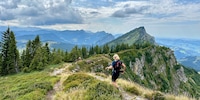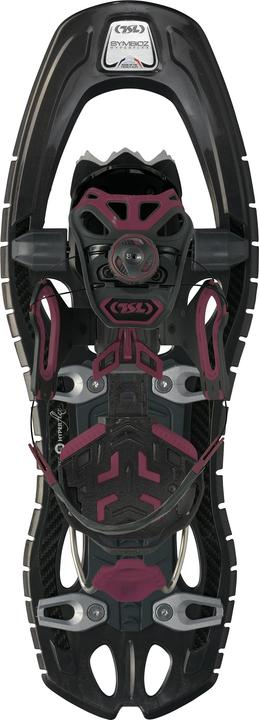
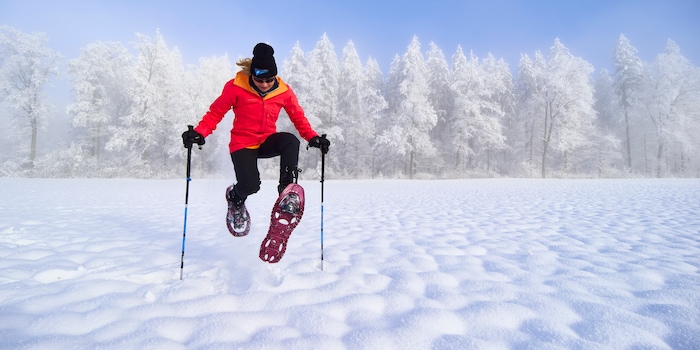
The snowshoes for dynamic hiking on winding trails
Strap on and off you go – snowshoes are the ideal way to easily traverse snow-covered winter landscapes. As I like to be sporty, I tested the lightweight and flexible Symbioz Hyperflex Instinct by TSL.
Snowshoe hiking is one of my favourite winter activities. I like trudging through the snow, breathing in the fresh winter air and roaming the countryside without the need for cross-country ski trails or pistes. Of course, in compliance with wildlife protection zones and wildlife rest areas and the current avalanche warnings. Schweizmobil has a good selection of recommended snowshoe routes.
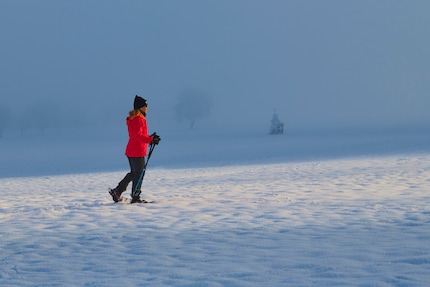
Source: Stefan Munsch
So far I’ve been wearing wide snowshoes with a rigid aluminium frame. Since they have a big surface area, they’re particularly good for deep snow. The only problem is it’s really tiring to walk in them because I have to lift my leg as if I’m doing a stork walk. On steeper terrain and longer tours, this saps your energy.
But that’s exactly what I’m after, I want to hike in the snow for longer and get some good elevation in. That’s why I’m fascinated by the flexible Symbioz Hyperflex Instinct snowshoes from TSL. They’re supposed to allow a natural walking movement and provide good support even on steep ascents and descents.
Since TSL, the manufacturer from the French Alps, has been making snowshoes for more than 40 years, these claims seemed relatively credible to me. But I still wanted to give the snow shoes a try. At the weekend, the time had come: on the first day, I hiked in a hilly landscape in the Swiss Plateau, and on the second, I hiked Lucerne’s local mountain, Mount Pilatus.
First impression: solidly made, light and easy to adjust
In size S and weighing in around 800 grammes per snow shoe, the Symbioz Hyperflex Instinct is on the lighter side. This is practical when you’re going to be wearing them on your feet. Plus, you can attach them to your rucksack or carry them in the bag they come with if you need to walk a bit before you reach the trail or snow border. The snowshoes are made of cold-resistant plastic with carbon reinforcement and stainless steel claws.

Speaking of size: the dimensions of the snowshoes depend on your weight. Of course you should also consider how much water, equipment and spare clothes you’re carrying. The Symbioz Hyperflex Instinct comes in three sizes:
** – S for 30 to 80 kg and for shoe sizes 35 to 41
**– M for 50 to 120 kg and for shoe sizes 39 to 46
** – L for 70 to 140 kg and for shoe sizes 44 to 52
When choosing a size, in addition to your weight and luggage, it’s also important to consider the terrain you’re travelling in. For this reason, there are overlaps in the weight specifications and shoe sizes. On winding trails with compact snow and icy passages or hard snow, smaller snowshoes are an advantage thanks to their manoeuvrability. Larger boots are the better choice for deep snow, as you sink in less thanks to the larger surface area.
Test day one: a short hike in the hilly Seetal Valley
To get the first impression, I set off to the snow-covered hills in my neighbourhood. Normally, putting on new snowshoes is always a lot of fiddling until the shoe size and binding are adjusted to your feet.
My experience with the TSL model is much more positive, the shoe size is simply adjusted with a sliding mechanism. It takes no time at all. And thanks to the Boa binding, I’m in my shoes in a matter of seconds. Boa bindings are popular for trail running shoes, snowboard boots, bike shoes and other sports shoes. The twisting mechanism allows you to adjust the fit precisely.
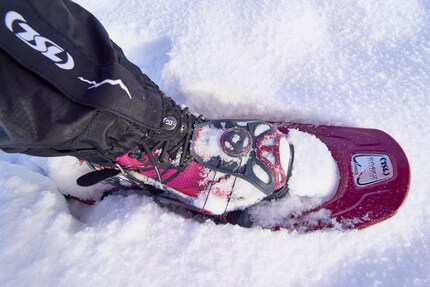
Source: Stefan Munsch
Spoiler: the Boa binding won me over on both test days. The snowshoes are quick to put on and take off. But what’s even more important to me is that the pull mechanism means the shoe fits perfectly and the pressure is distributed evenly. Unlike others, there are no pressure points, friction or cold toes from overtightened straps.
If I notice the shoe is too tight or too loose when I’m on the move, I can simply turn the wheel and readjust it thanks to the Boa lacing. The shoes are just as easy to take off as they are to put on: simply pull the wheel upwards and the cords loosen. You can even do it with gloves on.
After a few kilometres on the flexible snowshoes, it was clear that they’re well suited for dynamic running and even jogging in the snow. Yes, snowshoe running is a real sport, with federations, competitions and world championships. And a pretty effective winter workout at that.
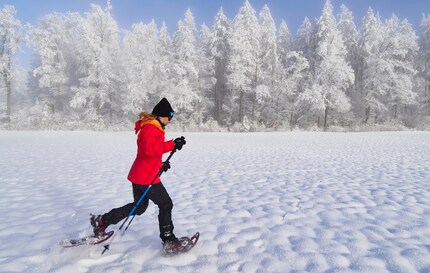
Source: Stefan Munsch
One reason the Symbioz Hyperflex Instinctfor performs so well, even on sporty hikes, is the high flexibility of the frame, which is achieved by the many notches on the sides of the shoe and the carbon reinforcement. This allows the plastic to bend without breaking.
Thanks to their adaptability and the tilt binding, common in snowshoes, you can walk naturally with a rolling motion in the snow. As the snowshoes are shaped like an hourglass and the spikes are under the foot and not on the edge, my shoes don’t clatter against each other when I walk and don’t get scratched like other snowshoes.
On the forest trail, the shoes show off their agility. They’re narrow, so I make good progress.
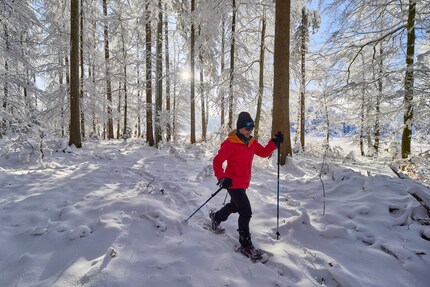
Source: Stefan Munsch
Thanks to their high flexibility, the Symbioz Hyperflex Instinct is made for uneven surfaces. After a good first impression, I wanted to test the snowshoes on more challenging terrain.
Test day two: ascent and descent on the Pilatus
For the next test, I’m drawn to Lucerne’s local mountain. I’ve chosen a route where I have to climb just under 600 metres and descend 600 metres – a total distance of ten kilometres. After admiring the mountain panorama and the sea of fog below me, I set off – downhill. From around 1,500 to around 900 m above sea level.
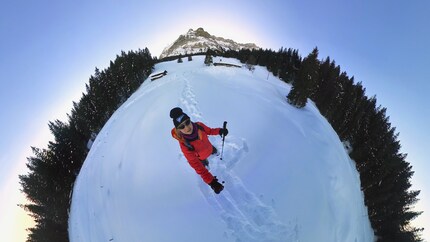
Source: Siri Schubert
First I take a wider hiking trail, then a steeper section with loose snow and then a winding single trail in the forest. What’s really important on the descent is slip resistance. This is where the eight stainless steel spikes really come into their own.
The bendability of the snowshoes also gives me support: thanks to their flexibility, I have a larger contact surface with the ground than with shoes with a rigid aluminium frame. Plus, the underside of the Symbioz Hyperflex Instinct is equipped with narrow plastic ribs, studs and edges that prevent slipping, even on loose snow.
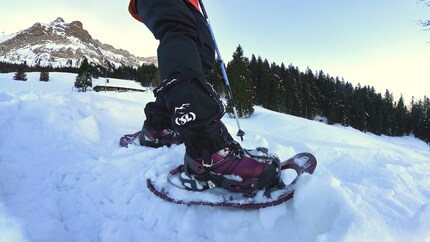
Source: Siri Schubert
Even on the forest path, which two hikers had warned me about because of the steep gradient, I don’t have any problems. The descent is complete.
From now on it’s uphill, back to the cable car station. Even on the first ascent, I learn to appreciate several features of the snowshoes. One is the ice claw, which reliably drills into the snow and ice at the forefoot, giving me a good grip.

Source: Siri Schubert
The other is the climbing aid, which folds flat under the shoe. A climbing aid works like a wedge under the heel. Instead of a steep tilt angle, I can put my foot down almost flat. My calves and Achilles tendons thank me for it.
The best thing is that I can easily push the climbing aid down with my pole. Theoretically, I can also click it back up again, but I don’t seem to be able to get it to work. Instead, I bend down briefly and bring the metal bar back into a neutral position.
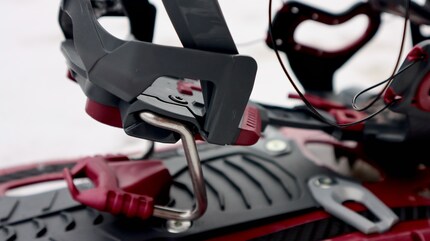
Source: Siri Schubert
After just under three hours, I arrive back at the starting point of the trek. The flexibility of the snow shoes meant that I could have a pretty natural walk and my feet, calves and thighs feel fresh and fit. The Symbioz Hyperflex Instinct showed their strengths on compact snow and inclines, and even in loose snow were still easy to run in.
Verdict: good running features for varied terrain
The Symbioz Hyperflex Instinct is a technically sophisticated piece of sports equipment for people who enjoy longer trips with a few metres of elevation gain. If you only occasionally walk on flat hiking trails, you probably don’t need these shoes, as they’re not exactly cheap. And if you mainly hike in deep snow, you’re better off with a wider model with more buoyancy. However, these snowshoes are well suited to winter sports enthusiasts who like varied terrain and also hike on trails. With them, running feels very natural, and your ligaments, tendons and muscles are protected so you can also go on longer hikes. The good grip provides safety on ascents and descents.
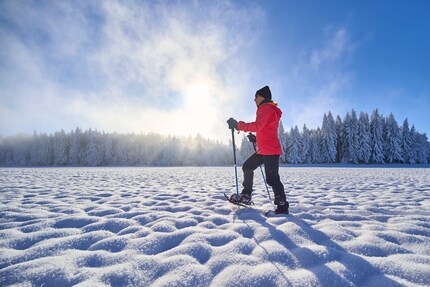
Source: Stefan Munsch
What I also like: TSL wants you to use your snowshoes for a long time. This is reflected in the high-quality manufacturing. If something does break, the company offers a repair service. You can also repair your shoes yourself: TSL has created a whole series of video tutorials, for example on how to replace the Boa lacing system. I was very impressed by the running characteristics of the TSL Symbioz Hyperflex Instinct on my first two hikes.
Header image: Stefan Munsch
Research diver, outdoor guide and SUP instructor – I love being in, on and around water. Lakes, rivers and the ocean are my playgrounds. For a change of perspective, I look at the world from above while trail running or flying drones.
